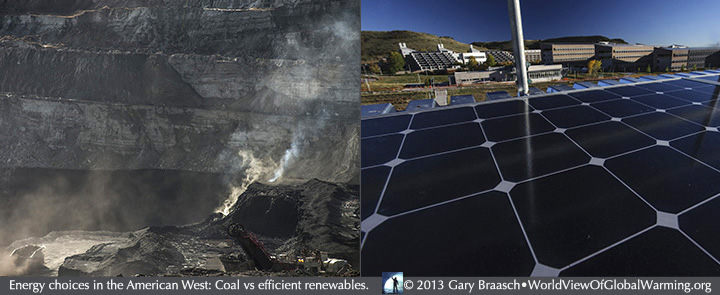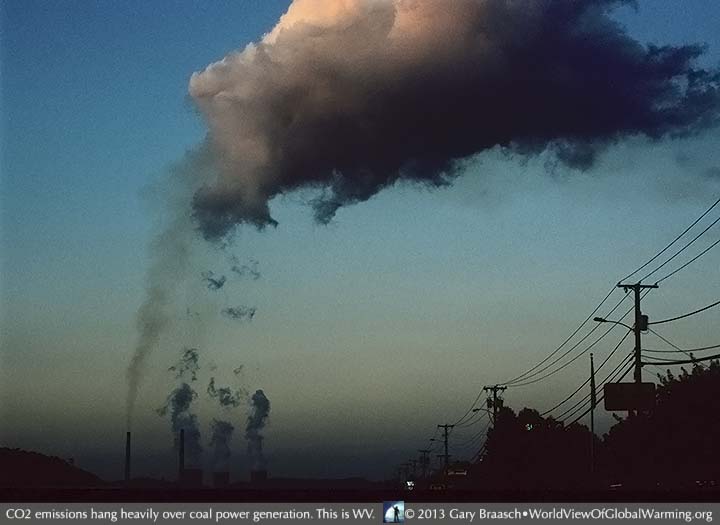Climate Photo of the Week
Energy choices in the American West -- 19th century coal still a major force in the 21st, along with the growing development of renewable energy and high efficiency.

The increasingly urgent and contentious choice among important energy sources is playing out across the vast western American landscape. In these images, a 20 foot high coal truck at lower left is dwarfed by the scale of the Eagle Butte coal mine in Wyoming; and the 1.1 mw solar array on a parking garage at the National Renewable Energy Laboratory in Colorado is part of the energy-neutral research complex in the background.
Coal, almost half of it mined in the Powder River Basin of Wyoming and Montana, still powers 37 percent of U.S. electrical energy, despite its pollution, damage to the land, and heavy greenhouse gas emissions. Coal's grip on American energy use has been weakened by the ready availability of natural gas (mostly methane) for electrical generation, but the threat to fresh water and health from the fracking used to extract gas throws this fuel into doubt. Fracking is also the reason for the huge increase in crude oil being pumped from the Bakken shale formation, centered on Williston, North Dakota. This energy rush puts increasing pressure on the water supplies, health, ranching and small town life of the northern plains because of the thousands of new wells, oil field workers, service vehicles, heavy trucks and expanding mining. Meanwhile, the Great Plains are a center of wind power and solar energy potential, and Colorado's National Renewable Energy Laboratory partners with industry to invent, test and develop non-carbon energy and high efficiency technologies -- which climate science increasingly suggests must be the energy of the future.
World View of Global Warming is beginning a new series of reports and images on this topic, in collaboration with The Daily Climate and its media partners. Photo stories will be published in the coming weeks. Opening portfolios will be from Colorado, Wyoming, Montana and North Dakota.
Carbon Dioxide spewing from U.S. coal power plants is target of EPA limits on CO2 from new plants; existing plant restrictions to follow.

New coal-fired power plants built in the U.S. will have to emit 20 to 40 percent less CO2 than existing plants, when a new EPA limit on the greenhouse gas announced September 20 goes into effect. The statement about the new rules in Washington by EPA Administrator Gina McCarthy was long anticipated, growing from a 2007 Supreme Court decision allowing regulation of carbon dioxide as a harmful air pollutant under the Clean Air Act, and President Obama's goal to reduce U.S. greenhouse pollution through Executive Branch actions. The rule is certain to face Congressional and court challenges from the coal and electrical generation industries. Even though the EPA said there are some new plants being built that could meet the standard, the technology to limit or capture and store CO2 is in its infancy and most current plant designs would not meet the new limits. The new emission levels will require new coal plants to emit no more than 1,100 pounds of carbon dioxide per megawatt-hour. Coal plants now operating pour out an average of 1,768 pounds. Currently 572 existing plants are the source of about 37 percent of U.S. CO2 emissions and about 44 percent of electricity. A new report by Environment America says that if just the top 50 largest plants "were an independent nation, they would be the seventh-largest emitter of carbon dioxide in the world, behind Germany and ahead of South Korea.... These power plants emitted carbon dioxide pollution equivalent to more than half the emissions of all passenger vehicles in the United States." The John Amos power plant on the Kanawha River, WV, pictured here, is the 14th most CO2 emitting plant in the U.S. EPA chief McCarthy said regulations for currently operating plants would be issued next year.
Gas-powered electrical generating plants will face a similar limit under the new rules, but they already emit far less than coal plants, an average of 800-850 pounds/mWh. "Natural" gas -- mostly methane, a strong greenhouse gas -- is extracted from thousands of wells by fracking the deep strata with a mix of toxic and water-polluting fluids, and faces increased scrutiny. Meanwhile, a steady switch from coal to gas as an industrial fuel that's cheaper and cleaner-burning -- along with new auto mileage standards and other efficiencies and the slowdown of the Recession -- has reduced American greenhouse gas pollution about 7 percent below 2005 levels. The U.S. remains the second greatest emitter behind China, and the world as a whole is sending up record amounts of greenhouse gas each year, which is reflected in the new IPCC reports on climate change to be issued beginning Sept 27. Please see below.
For more on the current state of global warming, why coal is such a polluting and deadly fuel, current actions and what should be done, please see the Actions page.

A single dedicated scientist’s 40-year study of seabirds in the Arctic is showing how global warming’s dire effects ricochet through entire ecosystems and food chains. Dr George Divoky says the melting away of Arctic Ocean sea ice in summer, which is coming faster than scientists predicted, will cause "the largest loss of an ecosystem the planet has experienced in modern times.” New satellite views show that now even in winter the Arctic ice is unstable. “You don’t have to care about Arctic seabirds or pack ice,” Divoky told World View of Global Warming, but the Arctic is not the only place where climate change is causing problems. “Species are struggling to deal with it,” he says, “and we are going to be in the same situation.”
Please see story and portfolio here.
Shellfish growers in the Northwest adapt to a changing ocean, treat seawater to maintain chemistry for tiny oyster larvae.
Since the industrial age began, the average pH of surface oceans has decreased to 8.1, a 30% increase in acidity, because of the additional absorption of carbon dioxide. This change is beginning to affect all ocean creatures which build shells, including reef-building corals which are already under stress from ocean warming. Especially affected are plankton, the tiny plants and animals at the base of the ocean food chain, including the larvae of shellfish.
In the Pacific Northwest, the oyster industry, with an $84 million yearly value and 3,000 employees, is already seeing and reacting to the effects of unhealthy ocean water.
Bhutan: “We commit ourselves to keep absorbing more carbon than we emit." Bhutan leads in environmental protection as climate change looms over this Buddhist kingdom of the Himalaya.
COPYRIGHT NOTICE:
Photography and text Copyright © 2005 - 2017 (and before) Gary Braasch All rights reserved. Use of photographs in any manner without permission is prohibited by US copyright law. Photography is available for license to publications and other uses. Please contact requestinformation@worldviewofglobalwarming.org. View more of Gary Braasch's photography here.



